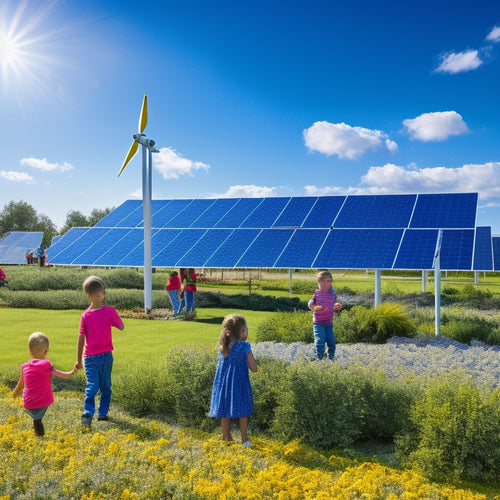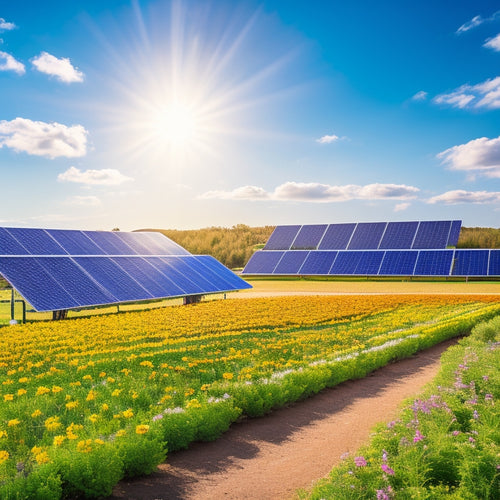
What Are the Environmental Impacts of Solar Energy Solar Panels?
Share
As you consider switching to solar energy, you'll want to know that while it's a renewable alternative, it's not entirely eco-friendly. Solar panels can disrupt natural habitats, threatening local wildlife and biodiversity. Manufacturing them generates greenhouse gas emissions and waste, while production is energy-intensive and water-hungry. Chemical risks and leak prevention are also concerns, as aging panels can contaminate soil and groundwater. Furthermore, solar infrastructure can harm local ecosystems and wildlife. While these environmental impacts exist, understanding them is essential to mitigating their effects - and there's still additional information to investigate about the complex relationship between solar energy and the environment.
Key Takeaways
- Large-scale solar farms require significant land areas, leading to habitat disruption and biodiversity loss.
- Solar panel production generates greenhouse gas emissions and contributes to air and water pollution.
- The production of solar panels generates significant waste, including defective panels and packaging, which can be minimized through effective lifecycle management.
- Solar panel production is water-intensive, straining local resources, and water conservation practices are essential.
- Aging solar panels increase the risk of chemical leaks, potentially contaminating soil and groundwater with hazardous materials.
Land Use and Habitat Disruption
As the world changes towards renewable energy sources, vast tracts of land are being repurposed to accommodate the infrastructure needed to harness solar power, sparking concerns about the environmental costs of this change.
You're likely aware that large-scale solar farms require significant land areas, which can lead to habitat disruption and biodiversity loss. The conversion of natural habitats into solar farms can result in the degradation of ecosystems, threatening local wildlife and their habitats.
However, it's important to note that you can mitigate these effects by incorporating land restoration and biodiversity enhancement strategies into your solar farm development plans.
This can include setting aside areas for conservation, creating wildlife corridors, and implementing sustainable land management practices. By doing so, you can minimize the environmental impacts of solar energy production while still reaping its benefits.
It's vital to strike a balance between meeting our energy demands and preserving the natural environment. By being mindful of land use and habitat disruption, you can guarantee a more sustainable future for generations to come.
Energy Payback Time Concerns
When you consider the energy payback time of solar energy, you need to account for the energy input requirements to manufacture and install solar panels.
This process consumes a significant amount of energy, which is typically generated by fossil fuels and results in greenhouse gas emissions.
You'll want to examine the manufacturing emissions released during this phase to understand the true environmental impact of solar energy.
Energy Input Requirements
The manufacturing process of solar panels requires a significant amount of energy, which raises concerns about the energy payback time (EPBT) - the time it takes for a solar panel to generate the same amount of energy used to produce it. You might wonder how this affects the overall environmental impact of solar energy.
As you consider integrating renewable energy into your power mix, it's crucial to understand the energy input requirements of solar panels. The EPBT varies depending on the type and efficiency of the solar panel. For instance, a high-efficiency solar panel with a shorter EPBT can start generating clean energy sooner, reducing its carbon footprint.
Conversely, a lower-efficiency panel may take longer to pay back the energy invested in its production.
To put this into context, the average EPBT for a solar panel is around 2-3 years. This means that after 2-3 years of operation, the solar panel has generated the same amount of energy used to produce it, effectively "paying back" the energy investment.
As solar panel efficiency continues to improve, the EPBT is expected to decrease, making solar energy an even more attractive option for those seeking to reduce their reliance on fossil fuels.
Manufacturing Emissions Released
Manufacturing solar panels generates emissions that contribute to greenhouse gases and climate change. You might think that solar energy is a clean and eco-friendly option, but the production process has its own set of environmental concerns. The raw material sourcing and manufacturing processes involved in creating solar panels release greenhouse gases, contributing to climate change.
The energy payback time (EPBT) is the time it takes for a solar panel to generate the same amount of energy that was required to manufacture it. This is a concern because the production process has a significant carbon footprint. The EPBT varies depending on the type of solar panel and the location where it's installed.
| Type of Solar Panel | EPBT (Years) | GHG Emissions (g CO2-eq/kWh) |
|---|---|---|
| Monocrystalline Silicon | 2.5-3.5 | 15-25 |
| Polycrystalline Silicon | 2.5-3.5 | 20-30 |
| Thin-Film | 1.5-2.5 | 10-20 |
Understanding the EPBT and GHG emissions associated with solar panel manufacturing is essential to mitigating the environmental impacts of solar energy. By choosing solar panels with lower EPBT and GHG emissions, you can reduce your carbon footprint and contribute to a more sustainable future.
Manufacturing Process Emissions
You're likely aware that producing solar panels and their components requires a range of energy-intensive processes, involving various chemicals and materials.
These processes emit greenhouse gases, contributing to climate change. The extraction and processing of raw materials, such as silicon and metals, result in air and water pollution. Additionally, the manufacturing process itself requires significant amounts of energy, often generated by fossil fuels, which further exacerbates emissions.
To mitigate these impacts, the industry is shifting towards more sustainable practices. You'll notice an increasing adoption of recycling technologies to reduce waste and conserve resources.
Manufacturers are also exploring the use of sustainable materials, such as recycled silicon and low-carbon aluminum, to minimize their environmental footprint. Moreover, efforts to increase energy efficiency and shift to renewable energy sources, like solar power, are underway.
As the industry continues to evolve, it's crucial to prioritize environmentally responsible manufacturing practices to guarantee the long-term sustainability of solar energy.
Waste Generation and Recycling
Waste Generation and Recycling
Frequently, the production of solar panels generates significant amounts of waste, including broken or defective panels, packaging materials, and leftover raw materials. As you consider the environmental impacts of solar energy, it's imperative to think about what happens to these waste materials.
Effective panel lifecycle management is vital to minimize waste generation and promote sustainability. You can adopt resource recovery techniques to recycle or repurpose waste materials, reducing the environmental footprint of solar panel production.
For instance, recycling solar panels can recover important materials like silicon, glass, and metals, which can be reused in new panel production. Additionally, recycling facilities can process waste materials to extract raw materials, reducing the need for primary resource extraction.
Water Usage and Pollution
In conjunction with land acquisition and raw material extraction, the production of solar panels relies heavily on water-intensive processes, which can lead to significant water usage and pollution.
You'll find that manufacturing solar panels involves various stages, including silicon production, ingot growth, and panel assembly, all of which require substantial water inputs. This can strain local water resources, particularly in water-scarce regions.
As you assess the environmental impacts of solar energy, it's crucial to evaluate the water usage and pollution associated with solar panel production.
To mitigate these effects, manufacturers can adopt water conservation practices, such as implementing efficient cleaning systems and reusing water in the production process.
Additionally, pollution mitigation strategies, like treating wastewater and implementing zero-discharge policies, can help minimize the environmental footprint of solar panel production.
Potential Chemical Leaks
As solar panels age, the risk of chemical leaks from the panels themselves and associated equipment increases. You should be aware that these leaks can contaminate soil and groundwater, posing environmental and health risks.
The primary culprits are photovoltaic (PV) modules, inverters, and battery storage systems, which contain hazardous materials like lead, cadmium, and selenium.
To guarantee chemical safety, it's crucial to implement leak prevention measures. You can start by selecting solar panels and equipment from manufacturers with a strong track record of chemical safety and leak prevention.
Regular inspections and maintenance can also help identify potential issues before they escalate. Additionally, proper disposal and recycling of decommissioned solar panels and equipment are critical in preventing chemical leaks.
Impact on Local Ecosystems
When you consider the impact of solar energy on local ecosystems, you'll want to examine the risks of habitat disruption, which can occur when natural habitats are altered or destroyed to accommodate solar infrastructure.
You'll also need to assess the hazards posed by solar panels to wildlife, such as birds and insects, that may collide with the panels.
Additionally, you should evaluate how large-scale solar farms can lead to land use changes, altering the surrounding ecosystem.
Habitat Disruption Risk
Solar farms and panel installations can fragment wildlife habitats, disrupting local ecosystems and threatening biodiversity. As you consider utilizing solar energy, it's crucial to acknowledge the potential habitat disruption risks.
| Habitat Disruption Risks | Mitigation Strategies |
|---|---|
| Habitat fragmentation | Conduct environmental impact assessments to identify sensitive habitats |
| Disruption of wildlife corridors | Implement habitat restoration measures to reconnect fragmented habitats |
| Loss of biodiversity | Develop biodiversity conservation plans to protect endangered species |
| Soil erosion and degradation | Implement soil conservation measures, such as revegetation and terracing |
| Conflict with agricultural land use | investigate co-location opportunities for solar farms and agricultural land use |
You can mitigate these risks by adopting sustainable practices, such as conducting thorough environmental impact assessments and developing biodiversity conservation plans. Additionally, implementing habitat restoration measures and soil conservation strategies can help minimize the disruption risks. By acknowledging and addressing these risks, you can guarantee that your solar energy project supports a balanced approach to renewable energy and environmental stewardship.
Wildlife Collision Hazards
Fragmented habitats and disrupted ecosystems can lead to another oft-overlooked impact of solar energy: wildlife collision hazards. As you consider the benefits of solar power, you may not think about the potential risks to local wildlife. However, solar farms can pose a significant threat to certain bird species and other animals.
-
Solar panels can reflect light, causing birds to mistake the reflection for a body of water or a suitable landing spot, leading to collisions.
-
The large, dark surfaces of solar panels can also cause birds to mistake them for vegetation or water, resulting in crashes.
-
Additionally, the infrastructure surrounding solar farms, such as power lines and towers, can further exacerbate the risk of wildlife collisions.
It's crucial to weigh these potential risks against the benefits of solar energy and consider strategies to mitigate these impacts, such as using bird-friendly panel designs or incorporating wildlife corridors into solar farm planning.
Land Use Changes
As you consider the environmental impacts of solar energy, land use changes emerge as another significant concern. The deployment of large-scale solar farms can lead to the alteration or destruction of natural habitats, disrupting local ecosystems. This is particularly true when solar farms are built on previously undeveloped land, such as grasslands or forests.
However, thoughtful solar farm design can mitigate these impacts. By incorporating agricultural integration, for instance, solar farms can be built alongside active farmland, reducing the pressure on natural habitats. This approach not only preserves biodiversity but also promotes sustainable agriculture.
Additionally, solar farms can be designed to mimic natural habitats, incorporating native vegetation and providing corridors for wildlife movement. By adopting these strategies, the environmental impacts of land use changes can be minimized, and the benefits of solar energy can be realized while preserving the integrity of local ecosystems.
End-of-Life Panel Disposal
At the end of their 25-year lifespan, photovoltaic panels are retired, leaving behind a trail of hazardous waste that poses significant environmental concerns. As you reflect on the environmental impacts of solar energy, it's crucial to contemplate what happens to these panels when they're no longer functional.
You'll be interested to know that the recycling of solar panels is still in its infancy. Currently, there are limited panel recycling methods available, and most retired panels end up in landfills or incinerators. This is concerning, given the toxic materials present in solar panels, such as lead, cadmium, and selenium.
Some key points to reflect on:
-
The recycling of solar panels can recover up to 95% of the materials used, including glass, metal, and silicon.
-
Implementing recycling programs can create new job opportunities and stimulate local economies.
-
Governments and manufacturers must work together to develop sustainable end-of-life management practices for solar panels, ensuring a more environmentally friendly solar panel lifespan.
Frequently Asked Questions
Can Solar Panels Be Used to Power Electric Vehicles Directly?
You can use solar panels to power electric vehicles directly, leveraging solar power efficiency to charge your car. With electric vehicle integration, you can utilize renewable energy, reducing emissions and reliance on fossil fuels, and increasing energy independence.
Are There Any Solar Panels That Don't Contain Toxic Materials?
As you commence on a quest for clean energy, you'll find that not all solar panels are created equal; some manufacturers are now using eco-friendly materials, prioritizing toxic waste management, and offering sustainable alternatives to traditional solar panel materials.
Can Solar Panels Be Installed on Historic Buildings or Landmarks?
You'll encounter regulatory challenges and aesthetic considerations when installing solar panels on historic buildings or landmarks, requiring careful planning to guarantee compliance with preservation rules and minimal visual impact on the structure's original character.
Do Solar Panels Work Efficiently in Shaded or Cloudy Areas?
You'll find that solar panels' efficiency drops considerably in shaded areas due to shading effects, and their cloudy performance is also compromised, but you can still generate some power, albeit reduced, in these conditions.
Can Solar Panels Be Integrated Into Building Architecture Seamlessly?
You'll be blown away by how seamlessly solar panels can integrate into building design, enhancing energy efficiency while flaunting sleek aesthetics that'll make your structure a modern marvel, all while utilizing the power of the sun!
Conclusion
As you weigh the benefits of solar energy, remember that even this eco-friendly option has its environmental drawbacks. Like a double-edged sword, solar panels can both capture the sun's power and exact a toll on the planet. While the benefits may outweigh the costs, it's essential to take into account the land use, emissions, waste, and pollution associated with solar energy. By acknowledging these impacts, we can work towards mitigating them and creating a more sustainable future.
Related Posts
-

Solar Power for Community Energy Independence
Solar power is essential for your community's energy independence, offering both environmental and economic benefits....
-

High-Performance Solar Solutions for Sustainable Living
High-performance solar solutions are your gateway to sustainable living, maximizing energy efficiency while considera...
-

Affordable Sustainable Building Materials for Homes
You can build an eco-friendly home on a budget by choosing affordable sustainable materials. Consider using reclaimed...


